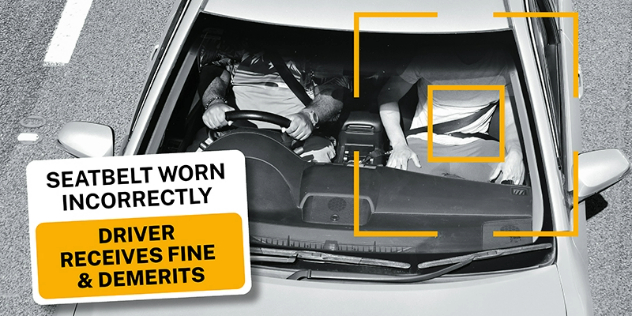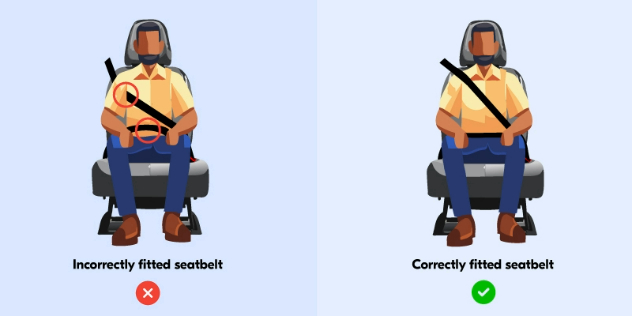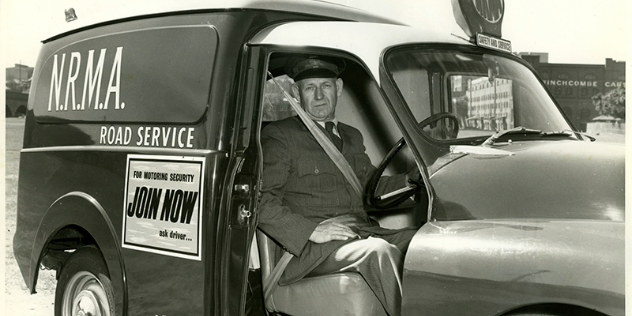What are the rules when it comes to wearing a seatbelt?

Even after decades of enforcement and awareness efforts, many thousands of people every year are fined in NSW for failing to wear a seatbelt correctly.
A seatbelt is more than just a strap of fabric. It's your lifeline in the event of a crash or abrupt stop, preventing you from being hurled forward or ejected from the vehicle. Wearing a seatbelt for all people in a vehicle has been a legal requirement in NSW since 1971, yet tragically, between 2019 and 2023, 150 lives1 were lost due to not buckling up.
Even today, despite the law and countless awareness campaigns, seatbelt non-usage remains shockingly prevalent. Astonishingly, 15 per cent of road deaths in NSW each year still involve individuals not buckling up.
What's even more alarming is these tragedies often occur on country roads with over 84 per cent2 of fatalities and two-thirds of serious injuries stemming from not wearing seatbelts in rural areas.
Wearing a seatbelt is a small action that can make a big difference in staying safe on the road. In this article, we look at the essential rules and penalties surrounding seatbelt use in NSW and valuable tips to ensure you and your passengers are properly secured.
Cameras now detect seatbelts not worn correctly
As of 1 July 2024, mobile phone detection cameras in NSW began enforcing seatbelt laws following legislation that was passed on 29 November 2023.
In the first three weeks of operation, the new seatbelt detection cameras have issued more than 11,400 fines, revealing a significant compliance issue. About 75 per cent of these fines were for improper use of seatbelts, with cameras capturing instances of unrestrained babies, children sharing seats with adults, and adults either not wearing seatbelts or wearing them incorrectly.
The number of offences detected in this short period has already surpassed the total seatbelt penalties issued by NSW Police in 2023, with the government estimating that over 100,000 fines could be issued by July 2025.

Penalties for improper seatbelt use detected by cameras have been in effect since 1 July 2024. Image courtesy of Transport NSW
Seatbelt rules in NSW
Drivers must always wear a seatbelt while driving and must keep all body parts inside the vehicle.
It's the driver's responsibility to ensure:
- Each passenger has their own seat equipped with a seatbelt, which should not be shared.
- Every passenger wears a properly secured and adjusted seatbelt or uses an appropriate child car seat based on age and size.
- The vehicle doesn't exceed its designated passenger capacity.
- No one occupies areas not meant for passengers, like the boot, floor, ute tray, or trailers.
- Passengers refrain from extending any body part outside the vehicle.
Passengers aged over 16 must:
- Sit in their own seat and buckle up properly.
- Avoid occupying non-passenger areas.
- Keep all body parts inside the vehicle.
These are the rules according to Road Rules 2014 – Part 16: Rules for person travelling in or on vehicles.
Penalties for not wearing a seatbelt
Failure to wear a seatbelt while driving or ensuring that your passengers are properly buckled up can result in fines and demerit points. Penalties start from $387 and three demerit points and double demerits apply. Moreover, passengers aged over 16 can face fines for not wearing seatbelts, as well as for any instance of protruding body parts outside the vehicle during travel. See the current list seatbelt offences and penalties in NSW.How to wear a seatbelt
Properly wearing a seatbelt is essential for your safety while driving or riding in a vehicle.
When it comes to wearing a seatbelt properly, Dimitra Vlahomitros, Principal Road Safety Advisor at the NRMA advises that “the sash should run from your hip to your shoulder and not ride up on your neck or pass across your upper arm.
The lap part of the seatbelt should sit across the bony section of the hips and under the belly.
If you're shorter or taller than average, you especially might need to adjust your seatbelt.
In most vehicles, the seatbelt is attached to the 'B-pillar' or the post where the front and rear doors meet. There is typically a mechanism that allows the attachment to slide up or down, so the belt sash will pass across your body in the correct position.
The seatbelt shouldn't be loose or have any twists in it.
An ill-fitting seatbelt may not restrain an occupant properly or could itself inflict injury in the event of a crash.”

Image created by The NRMA.
Remember, wearing a seatbelt is not just for your safety but also the safety of others in the vehicle. Always ensure everyone in the vehicle is properly buckled up before driving.
Never share a seatbelt between two people, as each belt is designed to protect one person only. It's essential to occupy a dedicated seat with a proper seatbelt; overcrowding or sitting in improper positions poses both legal and safety risks.
Wearing a seatbelt while pregnant
Wearing a seatbelt while pregnant is crucial for the safety of both the mother and the baby. It is always safest to use a three-point seatbelt (lap-sash), which includes a lap belt and a shoulder strap (sash). Achieving the right fit will help to ensure that you're safe and comfortable throughout the journeyProper seatbelt positioning
- Lap belt: Place the lap belt as low as possible, under the bump, below the bony part of the hips, and across the upper thighs to avoid pressure on the abdomen.
- Shoulder strap: The shoulder strap should be worn above the bump, over the collarbone, and, if possible, passing between the breasts.
A history of seatbelts and the NRMA
In the 1970s, the NRMA played a crucial role in advocating for road safety measures, notably pushing for the implementation of seatbelt laws in Australia. Despite initial resistance, the NRMA persistently campaigned for seatbelt adoption, leading to legislation mandating their use in NSW on October 1, 1971, with exemptions recommended. This resulted in a significant reduction in road fatalities and injuries within a year of implementation.
Beyond seatbelt laws, the NRMA continued to advocate for road safety, including child and infant restraints, leading to laws prohibiting the carrying of unrestrained children in the front seat by 1977, and the establishment of 'baby capsule' fitting stations in collaboration with authorities in the 1980s.

The NRMA leading the way on seatbelts fitting them in their patrol vehicles years before they became mandatory.
Today, the NRMA remains dedicated to enhancing road safety for Australian motorists through various means such as infrastructure improvements, vehicle safety, awareness campaigns and driver education. More recently, a sustained public campaign by the NRMA resulted in a child car seat manufacturer conducting a voluntary recall of a restraint that catastrophically failed crash testing. Today, NRMA's driver training and education programs play a pivotal role in promoting road safety, particularly by emphasising the importance of seatbelt usage to prevent injuries and fatalities.
Seatbelt rules in other Australian states
Seatbelt rules can vary slightly between Australian states and territories, though all mandate their use in motor vehicles. For specific guidelines, consult the relevant state or territory's government websites below or local transportation authorities.
- QLD - Seatbelt rules
- VIC - Seatbelts
- SA - Seatbelts and child restraints
- WA - Seats and seatbelts
- ACT - Seatbelts
- NT - Seatbelts
- TAS - Road rules booklet
Sources:






